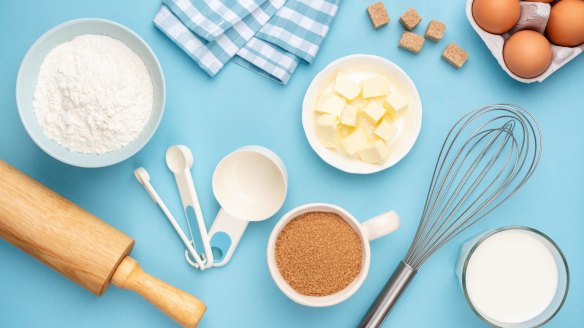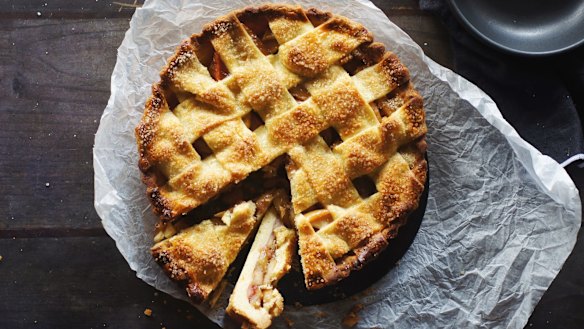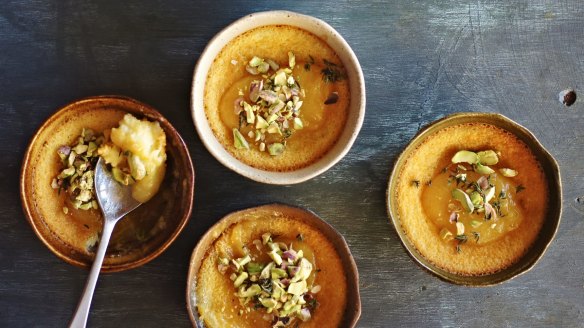Baking hacks: Substitutes, tricks and tips for a bare kitchen

Though it is true that baking is a science and that you should follow your cake recipes to every last detail, sometimes you just don't have every single ingredient in the pantry when you set out to bake. But this doesn't always mean you have to give up those fresh-out-of-the-oven cake dreams.
Katrina Meynink has offered us some of her baking lifelines – all the tricks you need from easy ingredient substitutes to equipment hacks and handy techniques to make your baking better.
Ingredient swaps when the cupboard is bare
No buttermilk: Combine 250ml (1 cup) of milk with 1½ tbsp lemon juice or white vinegar. Set it aside for five minutes or until it looks like it is curdling and has that background acidic taste. Alternatively replace with 1 cup Greek yoghurt.
No brown sugar: Mix white sugar and molasses together. For light brown sugar, add 1 tbsp molasses to 1 cup castor sugar. For dark brown sugar, add 2 tbsp molasses to 1 cup of castor sugar. Use a fork to mix until thoroughly combined.
No baking powder: To replace 1 tsp baking powder, substitute ½ tsp cream of tartar and ¼ tsp baking soda (bicarbonate of soda)
No eggs: Replace with 25ml (¼ cup) vegetable oil per egg in recipes where egg is used as a leavening agent
DIY self-raising flour: Add 2 teaspoons of baking powder for each 150g (1 cup) plain flour.

Make the most of the ingredients you do have
Roast your sugar
Roasted sugar still contains enough sucrose to behave like plain sugar in any given recipe. Use it to replace castor sugar in any recipe – it will change the taste slightly – less sweet with a faint hint of caramel/nutty background profile and is simply spectacular.
Preheat oven to 150C (130C fan-forced). Pour sugar into a glass or ceramic baking dish. Toast until the sugar turns ivory – just tanned in colour – about 1 hour. Stir well and continue roasting, now stirring once every 30 minutes, until darkened to light or sandy beige, 2–4 hours more depending on personal preference. Beyond that, the sugar will begin to liquefy.
Easily incorporate butter
Using a grater on frozen butter breaks the butter up into small pieces. Mix the butter shavings into the flour and your pastry or cake will come together with much less fuss.
Salted versus unsalted butter
In baking always use unsalted. Salt and liquid play a role in the toughening of gluten, not to mention that the amount of salt and the water content will vary greatly between salted butters, making it harder to be precise. Unsalted butter is likely to be fresher as its not destined for the long shelf life of unsalted butter.
Foolproof frozen fruit
Baking with frozen fruit can turn the best recipes into a soggy mess. The trick is to toss the fruit in flour until just coated. The flour will absorb some of the liquid and prevent a sodden mess. Alternatively use a small amount of tapioca flour.
If using the fruit in a clafoutis-style dish, put half of the batter into the pan and par cook before adding the remainder of the batter and fruit. This will prevent all of it sinking to the bottom.
Keep frozen cakes moist
If you are baking a cake for later use and need to freeze it. Leftover warmth is your friend. When the cake is still quite warm to the touch, wrap it in plastic wrap – the sweating of the cake in the wrap actually adds to the moisture in the cake and helps prevent it from drying out when you bring it back to room temperature to use.
Black beans can be a vegan substitute
The fibre, oil and liquid in black beans can replace any need for oil, egg or water that, say, a brownie mix may call for. Blending the beans creates a puree that stands in for the necessary moisture those ingredients would have otherwise provided.
Make your lemon zest, well, zestier
Save your knuckles and your wallet from expensive microplanes. Next time a recipe calls for sugar and citrus zest, just don't zest the citrus. Instead, strip the zest with a vegetable peeler, then combine those pieces with the sugar in a food processor. Pulse until the zest is minced and the sugar is colourful. Not only does this quickly process the zest but it also releases all those good citrus oils. In other words, brighter, zingier flavour.

Cooking equipment hacks
No baking weights?
If you're making a pie and want to precook your pastry first, place a second pie tin into the one lined with dough, creating a tin-dough-tin sandwich. Trim excess dough, then invert onto a baking tray and bake for the first 15 minutes. Gravity and the weight of the pie plate work in your favour to prevent puffing or shrinking.
Perfectly round cookies
Cut along the length of an old paper towel roll, then roll your cookie dough into a tube that's roughly the same diameter of the paper towel roll. Then, put the dough on a piece of plastic wrap, roll it up, and put it into the paper towel roll, squeezing it until it fits just right. Tighten it down with a couple of rubber bands, and you're all set. Put it in the fridge to firm up, or freeze for longer storage, and when you're ready to bake, slice it up in even pieces, put the individual cookie discs onto a baking sheet, and pop them in the oven.
Use the right tools for the job.
If you're baking anything with fruit, stay away from metal pans and stick to glass and ceramic bakeware instead.
Whip eggs in glass or copper bowls to help them stay glossy and firm without as much risk of becoming over whipped or grainy. The copper binds the egg white proteins/sulphur groups while clean glass and copper ensure minimal transfer of any residues to your eggwhites
Bring your hairdryer to the table
A small hairdryer in the kitchen is the quiet gift that keeps on giving:
- Use it to melt chocolate
- Use it to bring sheen back to the top of iced cakes and ganaches
- Warm the sides of a bowl
- Soften butter
